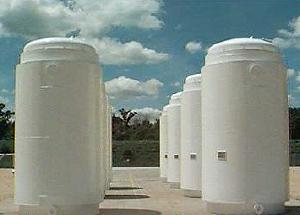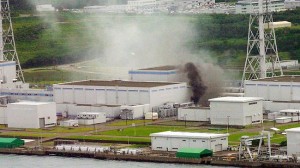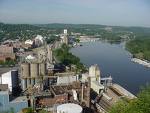Nuclear Waste in Minnesota Granite!
December 27th, 2011
Thanks to a reporter (THANK YOU THANK YOU THANK YOU!!!), I’ve got the recently release Sandia report:
Granite Disposal of U.S. High-Level Radioactive Waste – Sandia National Laboratories
This was released in August 2011. It’s making the rounds now.
Here’s the part that really scares me, right there on the first page:
Unlike the safety analyses for disposal in salt, shale/clay, or deep boreholes, the safety analysis for a mined granite repository depends largely on waste package preservation. In crystalline rock, waste packages are preserved by the high mechanical stability of the excavations, the diffusive barrier of the buffer, and favorable chemical conditions. The buffer is preserved by low groundwater fluxes, favorable chemical conditions, backfill, and the rigid confines of the host rock. An added advantage of a mined granite repository is that waste packages would be fairly easy to retrieve, should retrievability be an important objective.
Yes, it’s on page one (do I even want to read past page one? NOOOOO). What’s scary about that? Well, back in “Nuclear Waste Daze” representing Florence Township, I learned more than I wanted to know about “waste package preservation,” specifically a lot about weld flaws, about loading “ignition events”because they hadn’t considered the impacts of zinc and boric acid:
On May 28, 1996, a hydrogen gas ignition occurred during the welding of the shield lid on a ventilated storage cask (VSC-24) multi-assembly sealed basket (MSB). The gas ignition displaced the shield lid (weighing about 2898 kilograms [6390 pounds]), leaving it in place but tipped at a slight angle, with one edge about 7.6 centimeters [3 inches] higher than normal.
The loaded VSC-24 multi-assembly transfer cask (MTC), a shielded lifting device used to transfer the MSB loaded with spent fuel to the ventilated concrete cask, had been placed in the cask decontamination work area in the auxiliary building. Approximately 114 liters [30 gallons] of borated spent fuel pool water had been drained from the MSB to facilitate welding of the shield lid, creating an air space below the lid. The hydrogen gas ignition occurred during the initiation of the shield lid welding, approximately 11 hours after the loaded MTC had been removed from the spent fuel storage pool.
And then there’s the inability to unload a cask once it’s been loaded and used for storage for a while. for a Three Stooges HILARIOUS (if the truth wasn’t so scary) report on trying to unload a cask, “oops, an assembly is warped, oops, got stuck pulling out, oops, what to do, oops, let’s just ram it back in and put the cover on” at INEL:
The possibility of revival of the notion of storing nuclear waste in the Minnesota granite, and granite anywhere, is more than I want to think about.
Here’s a fun video with some shots that Northern States Power showed us back in the NSP sponsored “Task Force” prior to their application(we’re talking late 1994-early 1995 here), to show us how safe casks are:
Homer, you work at a nuclear plant – what do you think?
Boyd puts out nuclear welcome mat
December 22nd, 2011
AAAAARGH, there goes PUC Commissioner (former chair) David Boyd putting out the welcome mat for nuclear power, nuclear plants and nuclear waste. This we DON’T need…
And note that he’s claiming that the hurdles are “costs” and “public perceptions.” Ummmm… where’s safety? Minnesota is home to a Fukushima Dai-ichi GE nuclear reactor, located in Monticello, north, upriver and upwind from the metro.
Safety, anyone? But then, I’ve been to the Appellate Court about the responsibility of the PUC for assuring that the utilities provide “safe” electricity, and we were tossed out. Power Line Task Force v. Public Utilities Commission
THE HURDLES OF COSTS AND PUBLIC PERCEPTIONS
Published In: EnergyBiz Magazine November / December 2011
David Boyd
THE FUTURE OF THE U.S. ELECTRICITY PORTFOLIO is a complex matter that asks the industry to find a path forward that acceptably balances many different factors. Once one acknowledges that every generating technology carries physical, financial and environmental risks, the conversation can begin in an intellectually honest manner. In the case of the nuclear industry, the issues frequently discussed are the costs of new construction, safety and fuel management.
Why would a utility consider nuclear power when public opinion on the risks and rewards appears to swing more significantly than it does for other technologies? A response requires taking stock of the broader situation as it stands today, and then focusing on the nuclear industry specifically.
We are entering a period where utilities will retool their generation fleets for the next 40 or more years. Construction will need to be phased over time, and the optimum portfolio could change with the passage of time. Policy drivers of this build-out include electricity that is reasonably priced, increasingly low carbon and as clean as possible, together with North American Electric Reliability Corp. and Federal Energy Regulatory Commission mandates for reliability. In addition, the evolving domestic gas supply, economics and the anticipated U.S. Environmental Protection Agency mandates dictate that coal use will be reduced in the near term. Some argue that this translates into a natural-gas dominated electricity sector. While I accept a movement to natural gas in the near term, that fuel will not yield the complete decarbonization of the electricity sector necessary to meet, for example, the goal to reduce total greenhouse gas emissions to 80 percent below 2005 levels by 2050, as per a Minnesota statute, among other state and federal guidelines. While we have made significant progress with wind and other renewables that support the greenhouse gas targets, questions remain regarding the cost and reliability of integrating very large quantities of renewable energy into the grid.
So is there is a place for new nuclear in our generation fleet? Advocates suggest that the answer is yes, with careful consideration of specific issues. Aside from hydro, nuclear plants are the only low- or no-carbon baseload option of significant scale for many states. Nuclear is also a part of a balanced generation portfolio that is prized by many – but at what cost, at what scale and under what circumstances? If the goal is to maintain the present 20 percent of electricity generation from nuclear, we will need to replace 40 reactors whose operating licenses expire by 2030.
There are a number of hurdles that remain for expansion of nuclear power in the United States. Chief among these is the capital cost of construction. Despite projections that the levelized cost of electricity from newly constructed plants will be competitive with other generating technologies, the project costs are so high that most utilities would be betting their futures by pursuing a new reactor. In addition, the first movers would need to develop new institutional knowledge and confront the preparedness of our domestic workforce. This could add significant costs, even though the effect would benefit those who might follow. Although the federal government has authorized loan guarantees to help overcome these barriers, they are significant issues that limit early movers in the industry.
Secondly, the federal obligation to take possession of spent fuel and place it in a repository, as dictated by the Nuclear Waste Policy Act and standing contracts with the utilities, has not been fulfilled, and this inaction adds to uncertainty. The Blue Ribbon Commission on America’s Nuclear Future has proposed policy actions to address this issue. Even with swift acceptance of the commission recommendations, it may be 12 years before any spent fuel begins to move from present storage sites. Furthermore, there remain matters of active litigation over the suspension of licensing activities for Yucca Mountain, and disputes over the Nuclear Waste Fund fees.
City of Red Wing asks the right questions
April 25th, 2009
Remember Xcel isn’t too happy about the City of Red Wing intervening? See “Xcel not a happy camper” from last month.
Maybe it’s because Red Wing has a stake in this, as host to Xcel’s Prairie Island nuclear generating plant.
Here we see that in Information Requests in the Prairie Island uprate and dry cask docket at the PUC, the City of Red Wing is asking the right questions:
Here’s a couple that I find extremely amusing, starting with IR-21:
or this one… IR-22:
and IR-23:
and IR-24:
Yes, we are having fun now.
I wonder… will they give the City of Red Wing a copy of EPRI’s “The TN-24P PWR Spent-Fuel Storage Cask: Testing and Analyses” report? That’s EPRI report NP-5128. Let’s see the results of that “Three Stooges” INEL unloading attempt where the assembly got stuck half out, half in, and wouldn’t move… HILARIOUS, I’ve never seen such a rip-snortin’ report, hard to read between the lines without busting a gut!
Red Wing intervenes in Prairie Island uprate docket
March 25th, 2009
And what do you see waaaaay in the background? Why, it’s the Prairie Island nuclear plant! It’s been there so long that now they want to relicense it, but at the state, there’s an uprate and dry cask docket, and so there’s a state proceeding, not that there’s much chance of impact, but it’s there…







